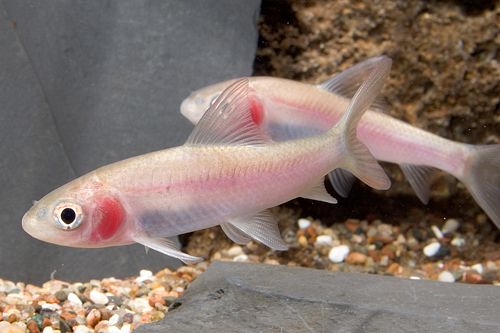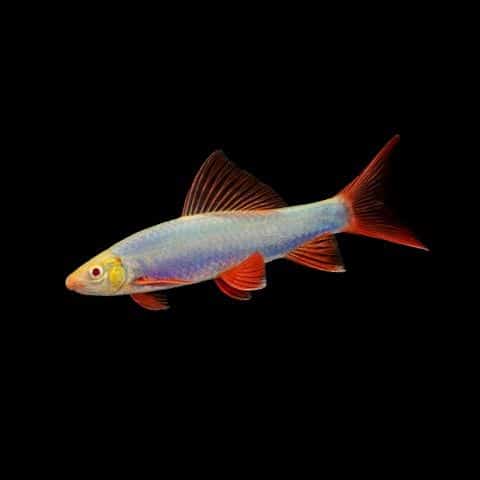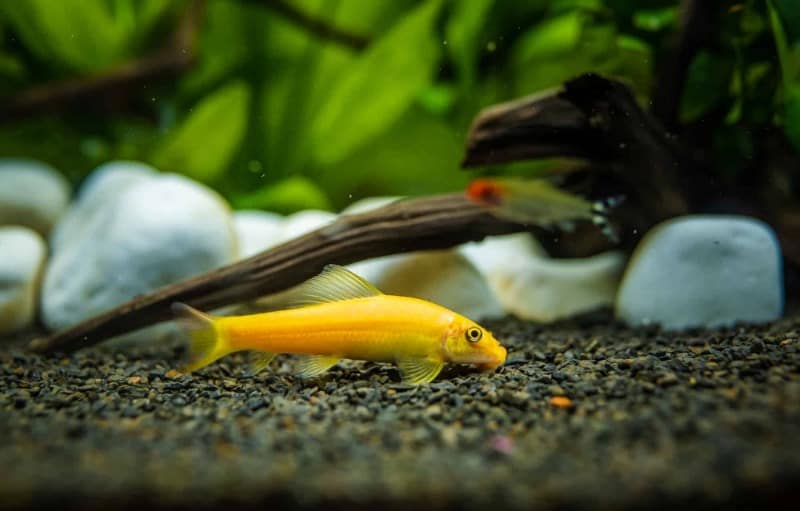The trend of housing sharks in freshwater aquariums has recently attracted more attention. Aquarium sharks are in high demand among fish lovers.
Still, most people instinctively picture a creature with sharp teeth, a streamlined, torpedo-shaped form, and a tall triangular dorsal fin when they hear the word ‘shark.’
Contrary to popular misconceptions, it’s cool to have a freshwater aquarium shark, regardless of the species. This recognizable fish group has played a significant role in how we relate to the aquatic world for hundreds of years. You can keep several freshwater shark species in your aquariums if you want a unique fish in your home.
Most aquarium shark species belong to the families, Pangasiidae and Cyprinidae and exhibit characteristics similar to actual sharks.
What Are Aquarium Shark Fish?
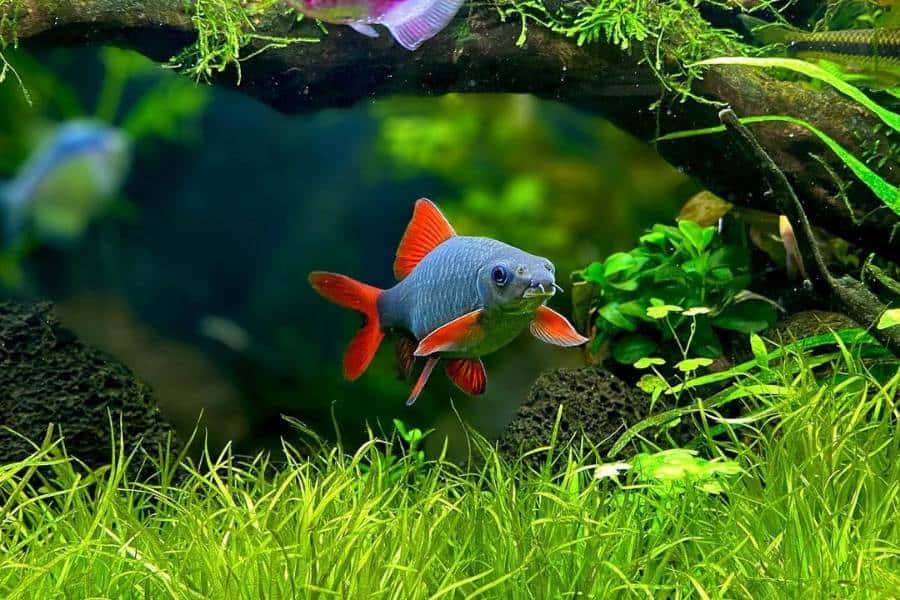
Aquarium shark fish aren’t sharks. While it’s unclear how a tiny group of aquarium fish started to be referred to as “sharks,” they all have key characteristics in common that resolve this long-standing mystery.
These are some common features among freshwater aquarium shark fish:
- They’re tropical cyprinids (carp), sometimes known as catfish, among the most well-liked aquarium fish worldwide.
- They’re bottom to mid-water dwelling fish with forked tails and pointed dorsal fins.
- All are simple to care for; most are widespread in their native habitats and have enough room.
- All can reproduce in captivity.
These fish were called “sharks” to make them more well-known aquarium fish. This strategy contributed to their immense popularity, making them one of the most prominent fish in aquariums.
Unfortunately, most aquarium sharks aren’t ideal for beginner aquarium owners with small tanks. The only exception is the little and docile Roseline Torpedo shark.
They are easy to feed, can tolerate any water conditions, and are either hostile, enormous or possess both traits.
Freshwater sharks are an intriguing fish variety that ends up as attractive specimens in most aquariums, provided you understand what you’re getting into. In this light, let’s examine the various freshwater aquarium shark types.
18 Common Freshwater Aquarium Sharks
Freshwater sharks are among the most active and attractive fish in the aquatic world. They move quickly, have distinctive shapes, and seem amazing when housed together.
You can find impressive aquarium sharks at almost any aquarium shop, and you’re bound to see one or several types on our list.
Here are the 18 most common aquarium shark fish species:
1. Rainbow Shark
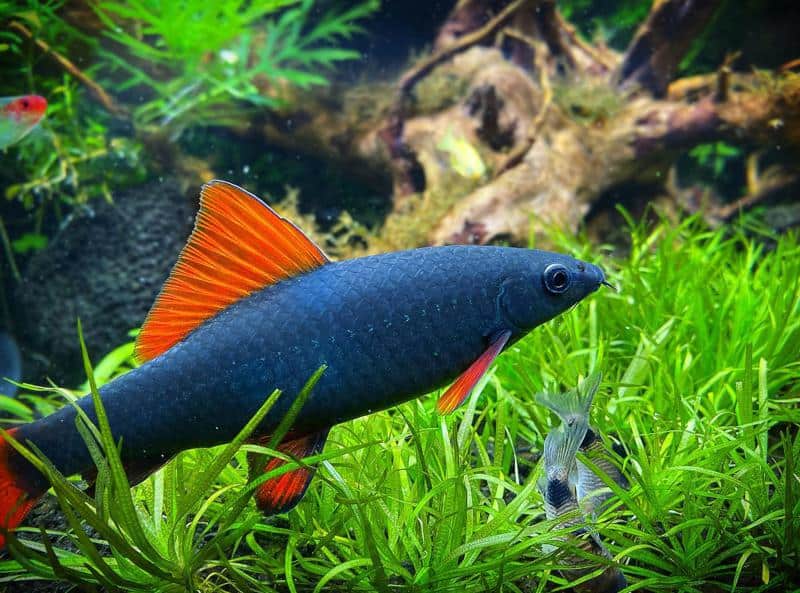
- Scientific Name: Epalzeorhynchos frenatum
- Breeding Difficulty: Beginner–Intermediate
- Aquarium Size: 30+ gallons
- Origin: Southeast Asia
- Fish Length: Up to 6 inches
- Temperament: Semi-aggressive
The rainbow shark—sometimes known as the red-finned or ruby shark—adds a great splash of color to any freshwater aquarium. Its flaming red tail shines amid a natural background, similar to the red tail sharks.
Similarly, rainbow sharks have vivid red fins. You can also see their fin glow in the sunlight because their fins are semi-transparent. Their red color looks frightening when combined with their body’s black coloring.
You can house these sharks with other fishes despite their aggressive tendencies. It’s best to keep them with fish that gravitate to the water’s surface since they’re bottom-dwellers. Still, they may act aggressive at times, so always be careful.
The rainbow shark is a naturally omnivorous species. They feed mainly on algae in the fish tank. However, the algae’s nutrients must be combined with high-quality live food and blanched vegetables.
2. Red Tail Black Fish
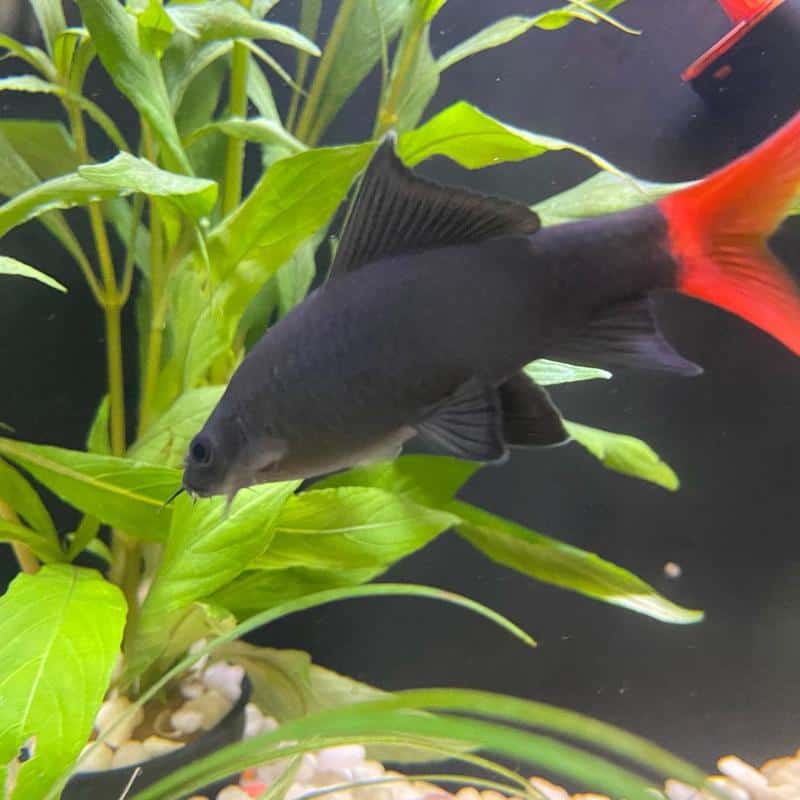
- Scientific Name: Epalzeorhynchos bicolor
- Breeding Difficulty: Intermediate
- Aquarium Size: 30+ gallons
- Origin: Thailand
- Fish Length: Up to 6 inches
- Temperament: Semi-aggressive
The red tail shark has been a much-adored fish species among aquarists for a long time. They were initially discovered in Thailand’s freshwater wetlands and lakes. Currently, they’re considered vulnerable, endangered, or threatened in the wild.
The reason these fish are so admired is easy to understand. Their name implies they have a bright red tail that stands out from their dark-black body.
Red tail sharks are quite resilient, which is a great trait. They may easily acclimate to various conditions. Nevertheless, their preferred range of temperature is between 72 and 79 degrees. They can also thrive with a pH balance of 6.5–7.5.
Since they’re true omnivores, red-tailed black sharks will consume everything you give them. They can eat prepared meals like flakes, blanched vegetables, frozen foods, and filamentous algae while kept in aquariums. They even consume algae, detritus, and bottom-dwelling animals in the wild.
3. Black Shark
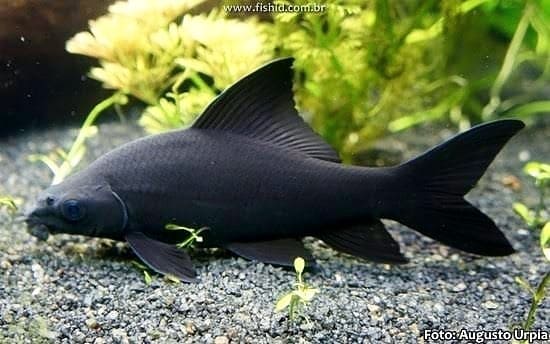
- Scientific Name: Labeo chrysophekadion
- Breeding Difficulty: Intermediate
- Aquarium Size: 180+ gallons
- Origin: Southeast Asia
- Fish Length: Up to 24–36 inches
- Temperament: Semi-aggressive
The black shark is a large fish species with a relatively aggressive nature and personality. These fish are found all across Malaysia and are liked by most people.
With its all-black appearance, the black shark has the well-known shape that several freshwater sharks possess. They also have a large dorsal fin. While the dorsal fin of a fish generally rests flat against its rounded body while swimming, it’ll occasionally become erect when the fish displays its strength.
The black shark is a particularly predatory and fierce fish. Therefore, aquarists shouldn’t raise them with any small fish. Most aquarists keep them in captivity with other ferocious species that can stand up to the Black Shark’s bully tendencies.
4. Albino Rainbow Shark
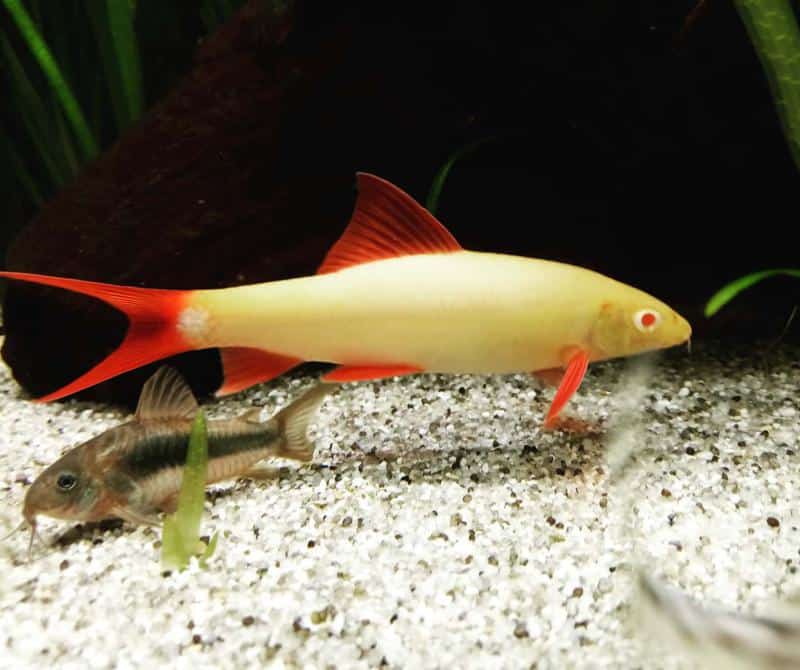
- Scientific Name: Epalzeorhynchos frenatum
- Breeding Difficulty: Expert
- Aquarium Size: 65+ gallons
- Origin: Thailand, Laos, Cambodia
- Fish Length: Up to 5–6 inches
- Temperament: Semi-aggressive
The albino rainbow shark, as its name suggests, is a white variation of the common rainbow shark. These fish also have red eyes and exceptional, vibrant red fins for which the species is recognized.
Ensure your tank is big enough and that you choose your other fish carefully because they have territorial impulses.
5. Siamese Algae Eater
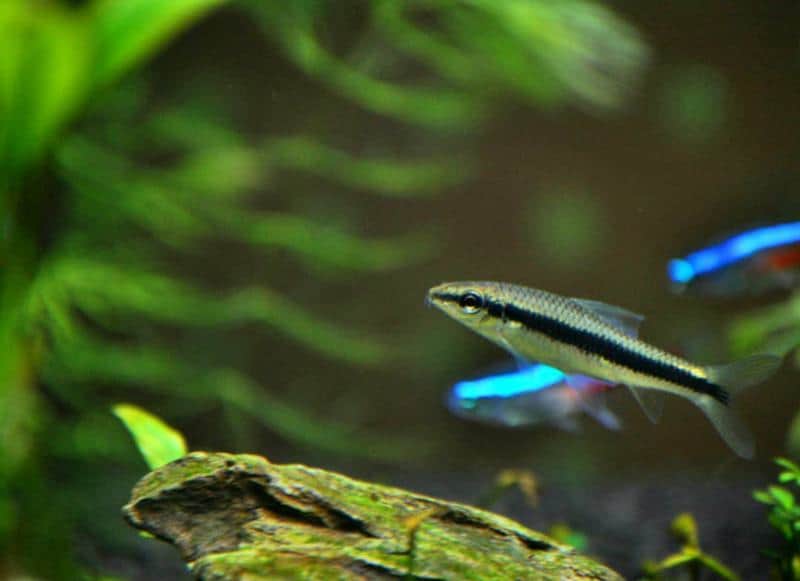
- Scientific Name: Crossocheilus oblongus, C. langei.
- Breeding Difficulty: Easy
- Aquarium Size: 30+ gallons
- Origin: Southeast Asia
- Fish Length: Up to 6 inches
- Temperament: Peaceful
The Crossocheilus genus has a group of roughly three different species known as siamese algae eaters. Some Siamese algae eaters are better for removing algae, and C. langei appears to be the most effective.
This rare shark species are peaceful communal fish. The siamese algae eaters have the incredible advantage of being one of the only aquarium species that happily consume unwanted “black brush” algae. As a result, they make fantastic sucker fish for growing freshwater aquariums.
6. Silver Apollo Shark
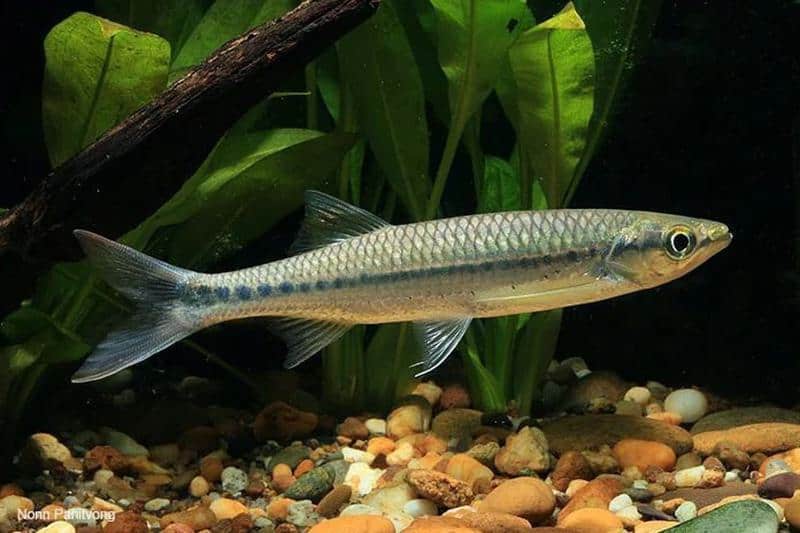
- Scientific Name: Luciosoma spp.
- Breeding Difficulty: Intermediate
- Aquarium Size: 120+ gallons
- Origin: Southeast Asia
- Fish Length: Up to 7 inches
- Temperament: Aggressive
A fish with a high activity level will actively spend time skimming the water’s surface in a quest for food. They’ll also go to the bottom in search of prey.
Contrary to this common behavior, silver apollo sharks prefer to stay at the top, while the majority of sharks in freshwater aquariums prefer to live at the bottom.
The silver apollo shark is known for its aggression. It’s a fish that hunts smaller prey whenever it has the opportunity. For this reason, they must be kept in tanks with larger semi-aggressive species.
Large gatherings are the best environmentfor them. The fish will combine as a group—known as shoals—to protect themselves against other aggressive species in the aquarium.
Another point to note about these fish is that they’re strong swimmers; their torpedo-shaped body contributes to their excellent swimming skills. Hence, they require massive swimming space. They’re mostly seen moving from one end of the tank to the other all day.
7. Bala Shark
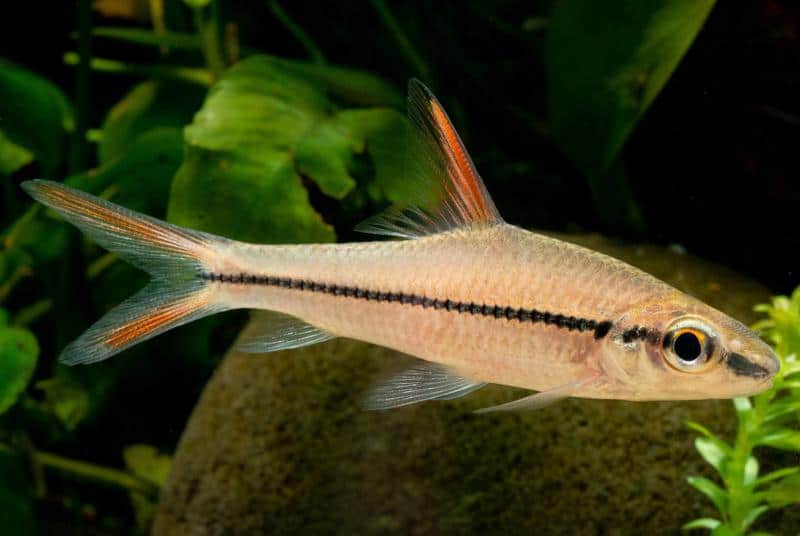
- Scientific Name: Balantiocheilos melanopterus
- Breeding Difficulty: Intermediate
- Aquarium Size: 125+ gallons
- Origin: The Malay Peninsula and Indonesia
- Fish Length: Up to 14 inches
- Temperament: Peaceful
Bala sharks are considered gentle giants despite their slightly menacing appearance. They get along well with a variety of fish and are generally calm. When they grow, they may begin to see smaller animals as prey, but for most of the part, they show some tolerance for other fish.
These sharks in the freshwater aquarium are outstanding in terms of aesthetics. The shark’s dominant color will often be gray. There are some different color combinations, but most species have similar appearances.
These sharks are natural omnivores. However, they like protein-rich treats like brine shrimp, bloodworms, and others.
Bala sharks consume plankton and other tiny floating invertebrates in the wild. However, they’ll readily consume various frozen and prepared foods in aquariums.
8. Chinese High-Fin Banded Shark
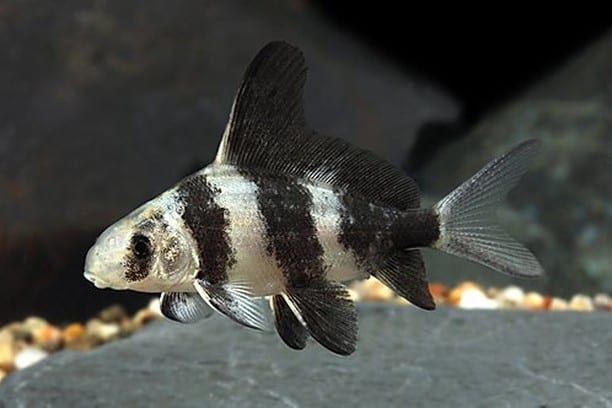
- Scientific Name: Myxocyprinus asiaticus
- Breeding Difficulty: Expert
- Aquarium Size: 300+ gallons
- Origin: China
- Fish Length: Up to 48–60 inches
- Temperament: Peaceful
The Chinese high-fin banded shark is a species that can only be kept in large aquariums or public aquarium facilities. They’re friendly creatures that usually get along well with others. They won’t act aggressively around various fish, so you can keep these fish with other fishes.
Chinese high-fin banded sharks have a unique appearance. However, only younger immature fish have that appearance. These sharks have three vertical stripes on their brown juvenile bodies.
This YouTube video sheds more light on the appearance of Chinese high-fin banded sharks.
These fish have a sucking mouth like Chinese algae eaters and have very unremarkable cigar-shaped bodies as adults. They eat algae, debris, and other organic material that grows on rocks in fast-moving rivers and streams. They completely transform in two years.
9. Harlequin Sharks
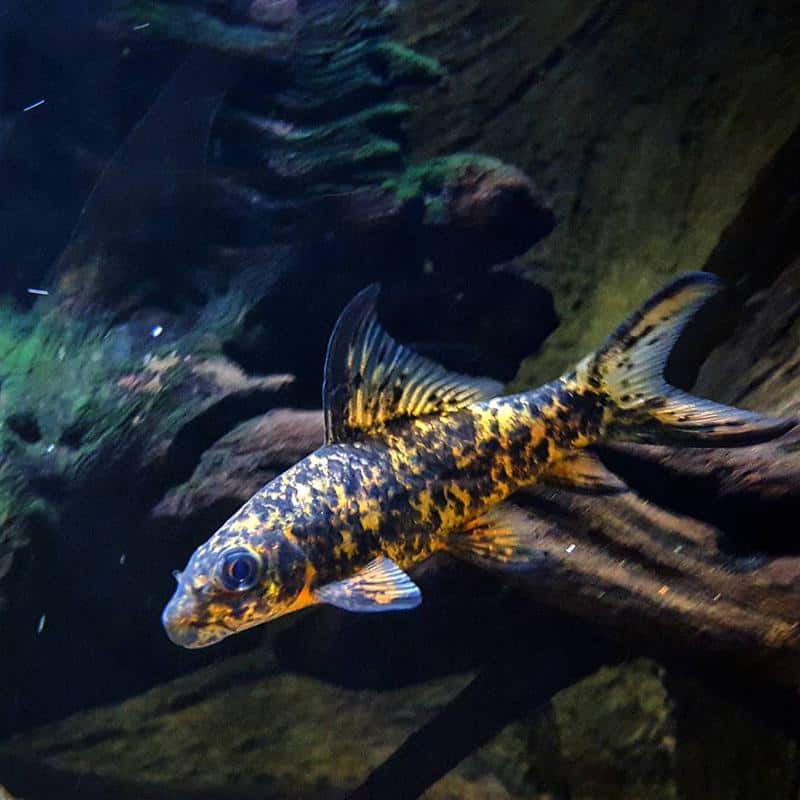
- Scientific Name: Labeo cyclorhynchus
- Breeding Difficulty: Intermediate
- Aquarium Size: 30+ gallons
- Origin: Congo River Basin, Africa
- Fish Length: Up to 6 inches
- Temperament: Semi-aggressive
Harlequin sharks are a fascinating addition to freshwater aquariums. They’re said to be a pretty mesmerizing fish species. Furthermore, this fish is considered to have a very lonely life.
The harlequin sharks are known to be very aggressive against animals with similar appearances. They don’t like to get close to any fish. It is important to note that you can’t keep them in groups or with other freshwater sharks.
The harlequin sharks need several hiding places to survive. Having drought-tolerant plants and a pile of rock or driftwood-built hiding places is essential.
It’s also not difficult to feed Harlequin sharks. Since they’re algae feeders, they’ll consume everything they can find at the tank’s bottom. Plant debris, algae, and tiny creatures all fall under this category.
10. Roseline Sharks
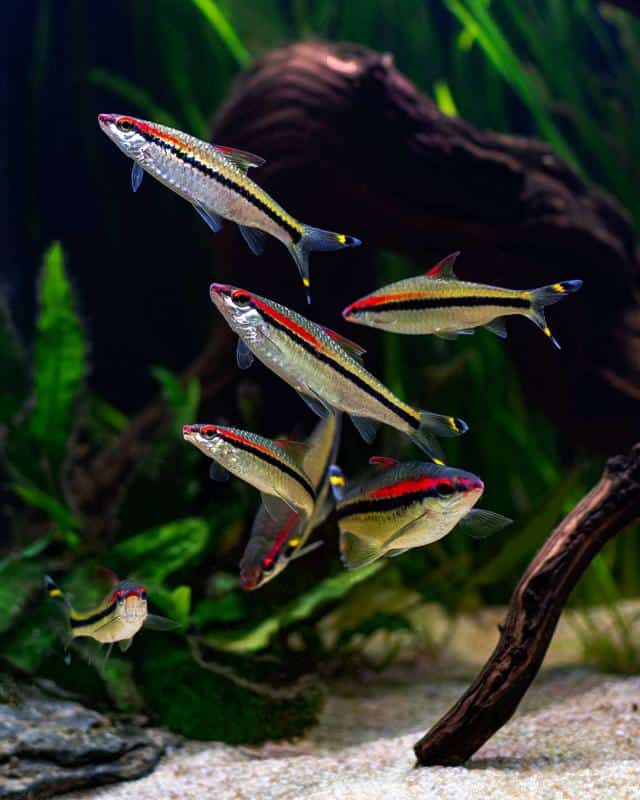
- Scientific Name: Sahyadria denisonii
- Breeding Difficulty: Beginner
- Aquarium Size: 30+ gallons
- Origin: India
- Fish Length: Up to 4–6 inches
- Temperament: Peaceful
These stunning fish are undoubtedly eye-catchers. The roseline comes in various striking colors that stand out well against the wild settings. You can see its visible patches of red, black, green, yellow, and gold stripes.
Roseline sharks won’t be an issue in terms of aggressiveness. They’re calm and don’t pay much attention to the other fish in their surroundings. The fish do much better and act more playfully when kept in groupings of four to six.
These sharks can survive in many different conditions. Although a temperature in the middle range is recommended, they can thrive at 60 to 77 degrees.
They do require a strong water current, though. So, it’s important to replicate the rivers and streams where the fish live.
11. Violet Blushing Shark
- Scientific Name: Labeo boga
- Breeding Difficulty: Intermediate
- Aquarium Size: 125+ gallons
- Origin: India and Pakistan
- Fish Length: Up to 12 inches
- Temperament: Peaceful
The violet-blushing sharks are far more peaceful than other freshwater tank sharks. They don’t act in a territorial way as other animals might. Therefore, they consequently thrive in communal tanks.
Despite this, you should keep these fish away from smaller species as they can mistake them for food. They thrive when housed with fish of similar size.
The violet-blushing sharks are named so because of their distinctive look. The fish have a silvery-white tint all over them. Their bodies have a shine that can be seen only when they’re present in bright lighting.
You can see each organ as their bodies are transparent. The shark’s gills are its most noticeable physical characteristic.
These fish require constant temperatures of 68 to 78 degrees to stay healthy. Furthermore, large swimming areas are also essential for the violet-blushing shark.
12. Columbian Shark
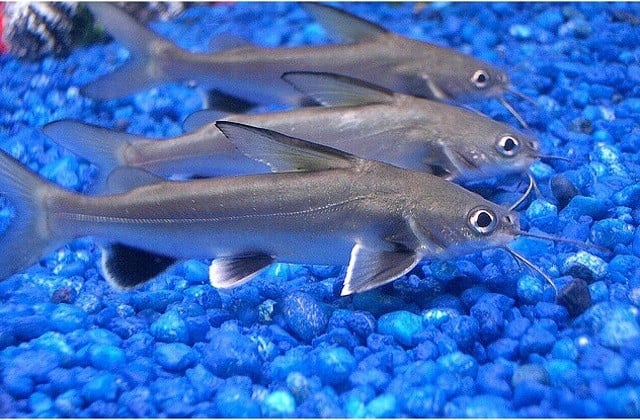
- Scientific Name: Ariopsis seemanni
- Breeding Difficulty: Beginner-Intermediate
- Aquarium Size: 75+ gallons
- Origin: Central and South America
- Fish Length: Up to 12 inches
- Temperament: Peaceful
This species could be relatively difficult to maintain — the care of the Columbian shark is quite stringent. Unfortunately, there’s a lot of false information about this fish.
Contrary to common assumption, not all of these sharks are freshwater species. They need brackish water to survive as juveniles. To ensure the tank’s gravity sits exactly between 1.005 and 1.010, you must add some sea salt when assembling the fish tank.
The Columbian shark fish has multiple sets of long barbels on their heads. They use these structures to explore their surroundings and find food.
13. Cosmic-Blue Glo Shark
- Scientific Name: Epalzeorhynchos frenatus
- Breeding Difficulty: Expert
- Aquarium Size: 65+ gallons
- Origin: Laos, Thailand, Cambodia
- Fish Length: Up to 5–6 inches
- Temperament: Semi-aggressive
The largest glofish currently available in aquariums are called Glo-sharks. Due to a genetic mutation created by scientists using genes from jellyfish, these fish get tbeir unique color.
The fish were modified to use them to detect environmental contaminants, but currently, they’re considerably more common as beautiful pets.
The rainbow shark has a striking variation known as the cosmic blue glo shark. It requires similar care like other species despite its neon color.
14. Galactic Purple Glofish Shark
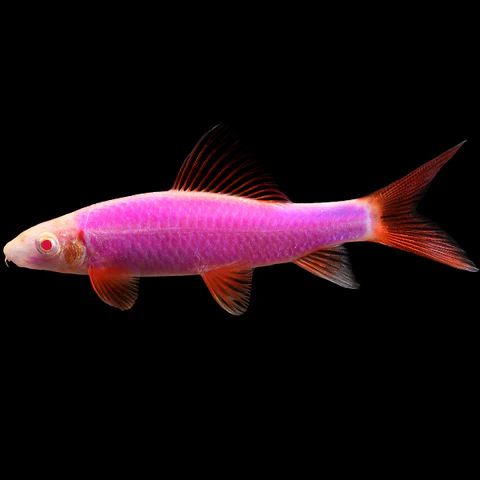
- Scientific Name: Epalzeorhynchos frenatus
- Breeding Difficulty: Expert
- Aquarium Size: 65+ gallons
- Origin: Laos, Thailand, Cambodia
- Fish Length: Up to 5–6 inches
- Temperament: Semi-aggressive
A color variant of the renowned rainbow shark is the galactic purple glofish shark. This fish has red eyes, a white face, and mild pink or purple undertones. This fish could be the perfect choice for you if you’re looking for a shark that’s bursting with color!
This YouTube video illustrates (sic) the galactic purple glofish shark.
An interesting fact about this fish is that their vibrant colorings aren’t the result of dyes or injections. They have their colors from birth and can produce offspring with the exact stunning appearance.
15. Electric Green Glo Shark
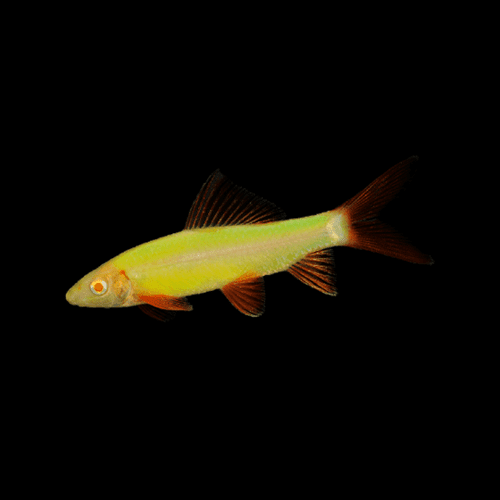
- Scientific Name: Epalzeorhynchos frenatus
- Breeding Difficulty: Expert
- Aquarium Size: 65+ gallons
- Origin: Laos, Thailand, Cambodia
- Fish Length: Up to 5–6 inches
- Temperament: Semi-aggressive
A unique gene was inserted into the albino rainbow shark to create electric green light sharks. These resilient, docile, and tranquil sharks are actually peaceful catfish. This rainbow shark variant has a maximum length of six inches.
They remain consistently glowy throughout their lives. These “man-made” fish still have their vibrant red fins, but their black bodies have been swapped out for vibrant glowy green ones.
16. Golden Shark
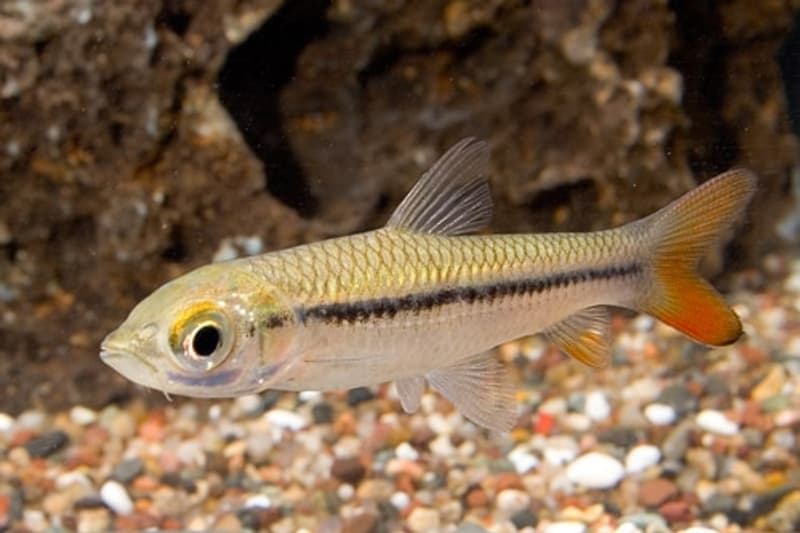
- Scientific Name: Leptobarbus rubripinna/ L. hoevenii
- Breeding Difficulty: Expert
- Aquarium Size: 220+ gallons
- Origin: Laos, Thailand, Vietnam, Cambodia
- Fish Length: Up to 48 inches
- Temperament: Semi-aggressive
The golden shark sometimes referred to as the red-finned cigar shark, is another enormous freshwater shark for caretakers of monster fish. These fish require giant tanks and can fit in large public aquariums far better than in a medium aquarium.
But if you have sufficient room, you may raise and feed these lovely carp-like fish with no problem. They’re attractive species with strong, red-tipped fins and noticeable scales!
17. Chinese Algae Eater
- Scientific Name: Gyrinocheilus aymonieri
- Breeding Difficulty: Intermediate
- Aquarium Size: 50+ gallons
- Origin: Southeast Asia
- Fish Length: Up to 8–11 inches
- Temperament: Semi-aggressive
Interestingly, the Chinese algae eater, popularly recognized as the sucking loach, doesn’t exist in China. This shark was raised in aquariums and is known for having strange and unsettling behavior.
These fish regularly attach themselves to other fish, especially large, slow-moving species. They do this because the victim’s slime coating provides them with nutrition. Moreover, they’re adept at maintaining a clean tank and mainly eat common food sources like algae.
18. Iridescent Shark
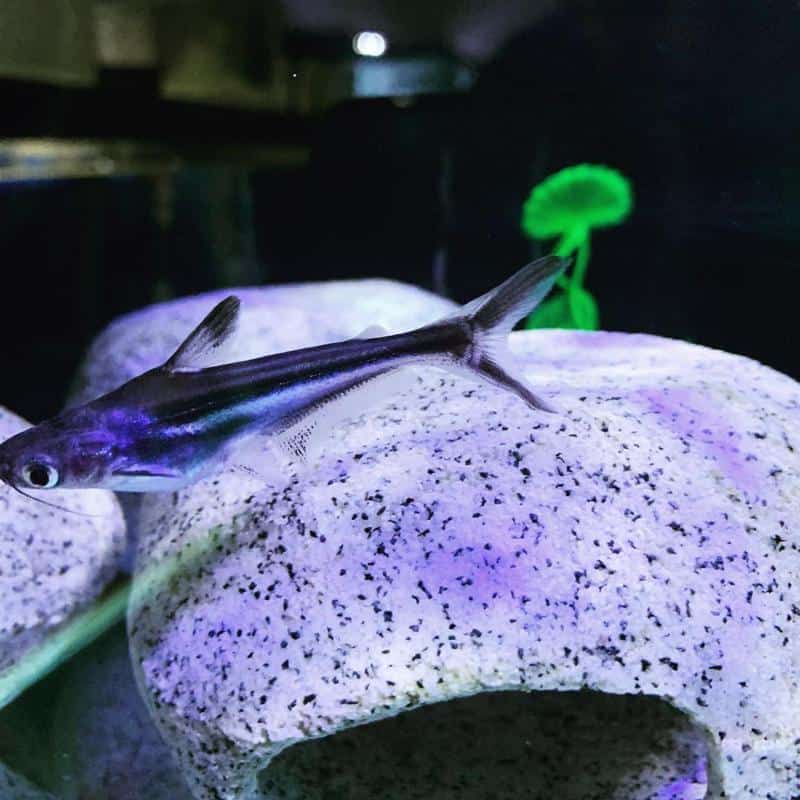
- Scientific Name: Pangasionodon hypophthalmus
- Breeding Difficulty: Expert
- Aquarium Size: 300+ gallons
- Origin: Southeast Asia
- Fish Length: Up to 24–36 inches
- Temperament: Peaceful
Iridescent sharks require a significant commitment and are native to Southeast Asia. These fish species not only grow big but have been known to survive twenty years or more! They’re therefore classified as species that only experienced aquarists should keep.
The iridescent shark has black, glossy skin that sparkles in the sun when it’s still young. Mature iridescent sharks are often a uniform shade of dark gray. In fact, the subdued tone develops gradually as the fish ages.
These aquarium sharks have a great appetite. Since they’re omnivores, you should change your offerings because they’ll consume almost everything. Additionally, there must be some variety to ensure they receive all their nutritional requirements.
Read More:
FAQs
What Do Sharks in Aquariums Eat?
In confinement, most freshwater sharks are omnivores. They’ll do well on a diversified diet that includes tropical granules, color flakes, shrimp pellets, aqueous tropical flakes, spirulina flakes, and algae rounds. Aquarists can also give frozen and live meals to promote development and color.
What Type of Aquarium Shark Resembles a Catfish?
The Pangasianodon hypophthalmus, often known as the iridescent shark, is a species of shark that resembles an actual catfish. It’s unique to Southeast Asian rivers.
Are Aquarium Shark Fish Suitable for Consumption?
No, they aren’t.
Fish kept in aquariums aren’t subject to the same regulations and inspections as fish kept for human consumption. Hence, they’re not intended for human consumption.
Conclusion
Freshwater sharks are among the most fascinating aquarium creatures. Yet, caring for these special animals requires commitment, especially for the large species. It’s best to choose an aquarium shark type based on your experience, time, and available resources.
